African adornment carries deep cultural significance through materials, colors, and techniques that date back to 1000 BC. You’ll find beadwork symbolizes status and identity, with colors like blue representing sustenance and red for bravery. Try traditional methods such as peyote stitch, explore scarification patterns, and understand how trade routes influenced regional styles. Don’t overlook how contemporary artists blend ancient techniques with modern designs. These cultural treasures reveal fascinating stories beyond their beautiful appearances.
The Origins of Beadwork in Ancient African Societies
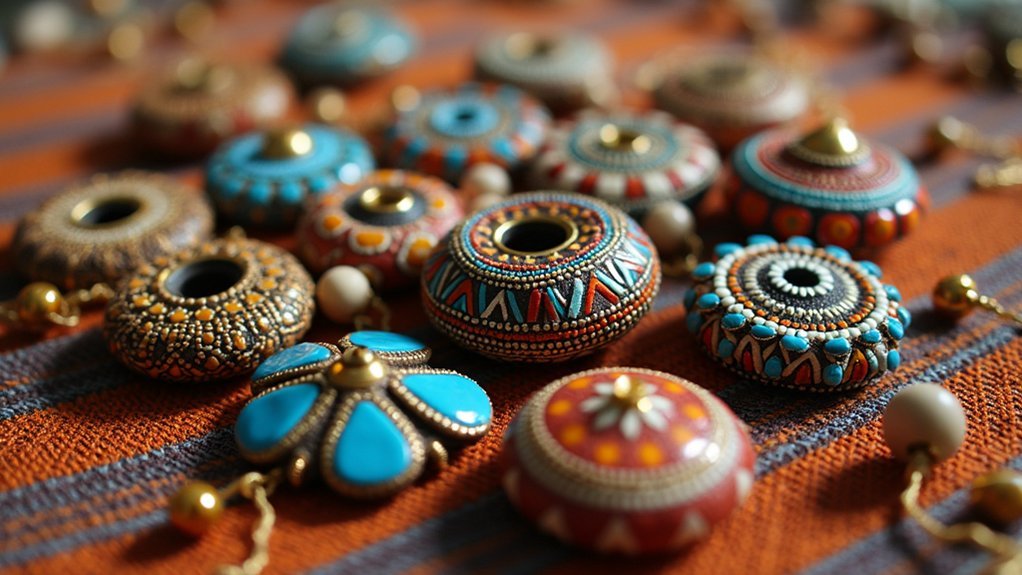
While many contemporary art forms struggle to trace their lineage beyond a few centuries, African beadwork stands as a proof of human creativity spanning millennia. Archaeological findings from the Nok culture in present-day Nigeria reveal beadwork traditions dating back to 1000 BC.
You’ll find that beads served far beyond mere decoration in ancient African cultures. These intricate designs communicated social status, wealth, and identity within communities. The labor-intensive craft—involving weaving, stitching, and stringing—demonstrated the remarkable patience and skill of early artisans.
As you explore different regions of Africa, you’ll notice distinct beadwork styles, with variations in materials, colors, and patterns reflecting the rich cultural significance of local traditions that supported social and economic structures.
Material Selection and Symbolism in African Adornment
African adornment materials speak a language all their own, communicating complex social messages through carefully selected elements. When you examine traditional African accessories, you’ll discover that material selection extends beyond decoration to establish cultural identity.
| Material | Symbolic Meaning |
|---|---|
| Beads | Social status, personal narratives |
| Textiles | Cultural heritage, social position |
| Wood | Connection to ancestral traditions |
| Metal | Wealth, prosperity, strength |
| Colors | Blue (sustenance), Red (bravery), Green (health) |
The significance of these elements varies across regions. For instance, Kente cloth displays intricate patterns that tell stories of heritage, while scarification creates permanent body art representing tribal belonging. Recycled glass beads aren’t merely decorative—they’re visual biographies that showcase one’s life journey and position within the community.
Traditional Techniques for Creating Tribal Jewelry
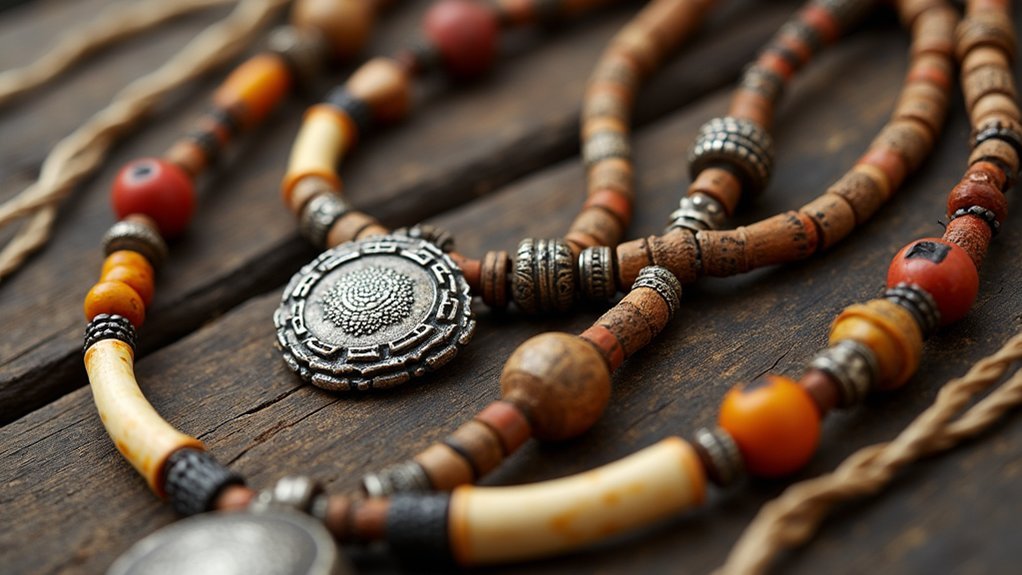
Throughout generations, the creation of tribal jewelry has embodied not just artistic expression but sophisticated technological knowledge developed over centuries. When you examine traditional techniques like peyote and brick stitch, you’ll appreciate the remarkable patience and precision required.
The most distinctive tribal jewelry methods involve intricate beadwork, with each African culture developing unique approaches. The Maasai culture particularly evolved from using local natural materials to incorporating tiny glass beads, adapting their techniques while maintaining cultural significance.
If you’re interested in these art forms, understand that loom weaving and hand-stitching methods represent more than decorative skills—they’re storytelling devices. The colors and patterns chosen often signify social status, mark important life changes, and communicate tribal identity through carefully preserved traditional techniques passed through generations.
The Role of Scarification and Body Painting as Adornment
Beyond jewelry and beadwork, permanent and temporary body modifications represent some of the most profound forms of African cultural expression.
Scarification, practiced in Chad, Ethiopia, Nigeria, and Zaire for over a century, involves deliberately cutting the skin to create decorative patterns that signify cultural identity and social standing. These permanent marks connect individuals to their community and spiritual beliefs.
Body painting serves as a temporary but equally meaningful form of adornment. Using natural materials like clay and dried plants, tribes like the Nubamen and Maasai create vibrant designs that indicate life stages, celebration, protection, or mourning.
The colors you’ll see aren’t random—they tell stories about the wearer’s role, achievements, and spiritual connection within their tribal context.
How Status and Identity Are Expressed Through Ornaments
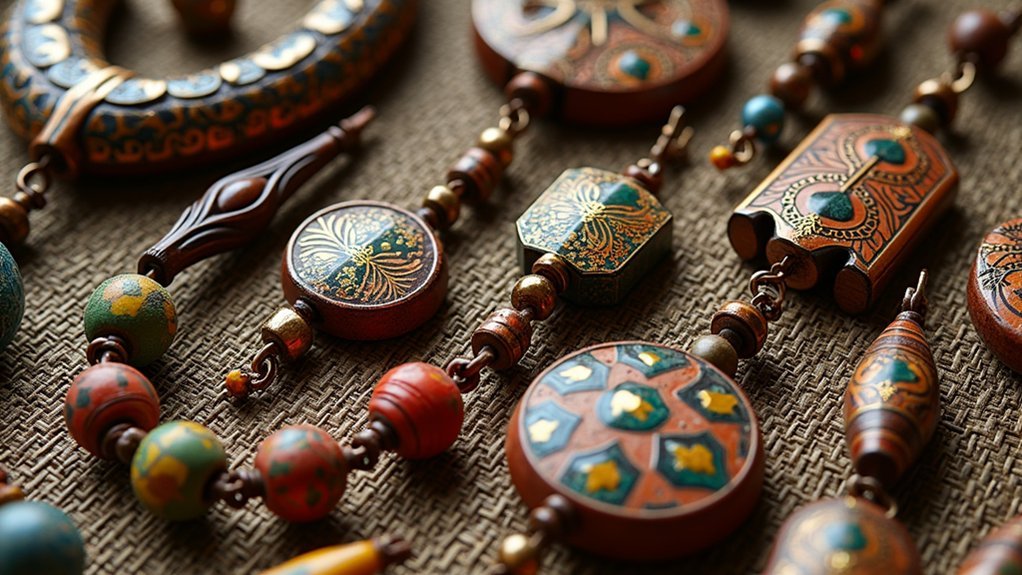
When examining the complex social fabric of traditional African societies, ornaments serve as powerful visual indicators of an individual’s place in the community.
You’ll notice how these adornments communicate social status and cultural identity through their materials, colors, and intricate designs.
- Ndebele marriage aprons (ijogolo) visually announce a woman’s married status while connecting her to ancestral lineage.
- Color choices in beadwork aren’t arbitrary—blue represents sustenance while red symbolizes bravery across many tribes.
- Igbo Ukwu elites distinguish themselves through luxurious beads and bronze, showcasing both wealth and trade connections.
- The Bamileke elephant mask embodies power and belonging, reinforcing social hierarchy through artistic expression.
- Traditional body modifications like scarification don’t just decorate—they mark life stages and tribal affiliation, making the body itself a cultural canvas.
Regional Variations in Adornment Across the Continent
As you travel across Africa’s diverse landscapes, you’ll discover that adornment practices shift dramatically from region to region, each area developing distinctive artistic signatures deeply rooted in local history and environment.
The cultural diversity and richness are evident in South Africa, where Zulu and Xhosa beadwork tells stories through specific colors and patterns, indicating social status and life stages.
In North Africa, Amazigh jewelry displays regional variations influenced by historical trade routes, while West Africa’s Asante people weave Kente cloth with symbolic significance in every thread.
Nigerian Yoruba traditions feature waist beads that celebrate womanhood and fertility—a beautiful example of how artistic expressions vary geographically.
These regional variations showcase Africa’s extraordinary adornment heritage, each piece carrying centuries of cultural meaning and technical innovation.
The Impact of Trade Routes on African Jewelry Development

You’ll find that trans-Saharan trade networks created dynamic crossroads where African jewelry makers incorporated silver, gold, and precious stones from distant regions into their distinctive regional styles.
These exchanges weren’t limited to materials alone, as artisans adopted and adapted techniques from Arab and European traders, creating fusion designs that reflected both cultural preservation and innovation.
Maritime trade along coastal regions similarly transformed adornment practices, introducing new materials and aesthetic influences that specialized artisan communities like the Yoruba integrated into their traditional beadwork and metalcraft traditions.
Saharan CrossCultural Exchange
The sprawling network of Saharan trade routes served as vital arteries for cultural exchange, profoundly shaping African jewelry traditions for centuries.
You’ll find that African communities transformed their adornment practices through exposure to diverse materials and techniques. Gold became both an intricate artistic medium and valuable trade commodity, while metalworking innovations allowed artisans to develop more sophisticated styles reflecting cultural and symbolic meanings.
- Amazigh jewelry designs blended local craftsmanship with imported influences
- New beads acquired through trade enhanced artistic complexity of regional pieces
- Metalworking techniques spread across different communities, creating distinctive styles
- Jewelry served as visual markers of cultural identity and social status
- Cross-regional aesthetic influences created a rich tapestry of adornment traditions reflecting the dynamic nature of Saharan exchange
Maritime Trade Influences
Three major maritime trade networks dramatically transformed African jewelry traditions between the 8th and 19th centuries. You’ll find that coastal exchanges along the Swahili Coast, Mediterranean routes, and European colonial trade all introduced new materials that revolutionized adornment practices.
| Trade Route | Impact on African Jewelry |
|---|---|
| Swahili Coast | Introduction of Asian glass beads and metalwork techniques |
| Trans-Saharan | Movement of gold, gems, and North African design aesthetics |
| European Colonial | Proliferation of Venetian glass beads transforming beadwork |
| Indian Ocean | Pearl trading and silver filigree methods |
When you examine traditional pieces, you’ll notice how artisans incorporated foreign materials while maintaining cultural identity. These imported elements weren’t merely decorative—they signified social status within communities, with rare trade goods often reserved for royalty and nobility.
Sacred and Ceremonial Significance of Adorned Objects
Deeply embedded within African cultural traditions, adorned objects transcend mere decoration to become powerful vessels of spiritual meaning and ceremonial importance.
When you examine African adornments, you’ll discover they’re integral to sacred rituals marking significant life shifts. Body adornments like jewelry, textiles, and scarification connect wearers to their ancestors and community, reinforcing cultural significance during ceremonies.
- Scarification serves as a rite of passage symbolizing bravery and community belonging
- Masks adorned with patterns invoke spiritual powers during ceremonial gatherings
- Specific colors and symbols in beadwork represent fertility, health, and social status
- Jewelry worn during rituals signifies important life events like births and marriages
- Materials used often have sacred properties connecting wearers to ancestral spirits
Contemporary African Adornment Artists Preserving Heritage
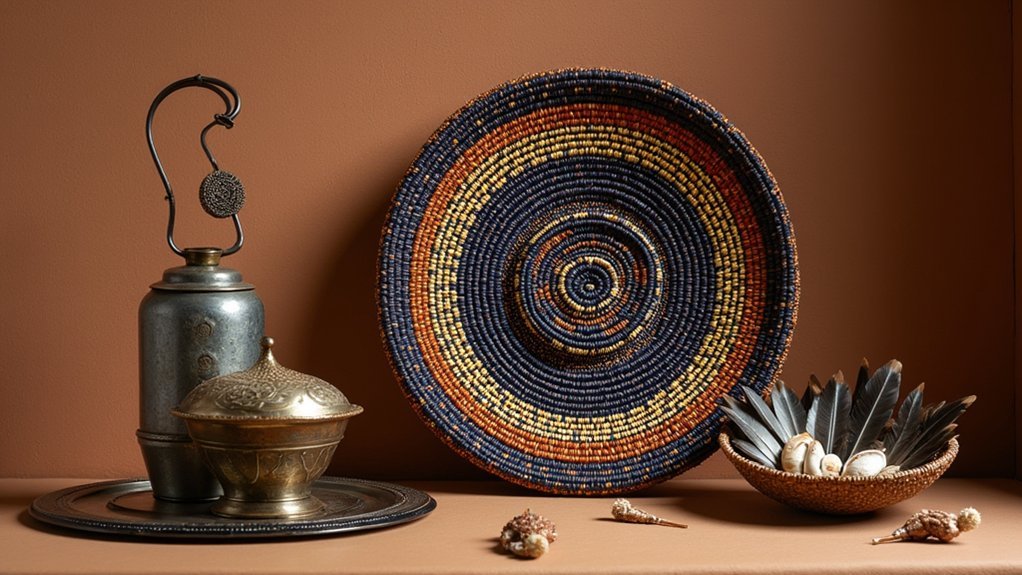
Contemporary African adornment extends beyond traditional practices into vibrant artistic expressions that bridge ancient techniques with modern sensibilities.
You’ll find artists like El Anatsui transforming discarded materials into spectacular installations that honor cultural heritage while challenging identity conventions.
Explore the work of Yinka Shonibare, who critically engages with colonialism through Dutch wax cloth—a fabric emblematic of complex African-European relations.
Contemporary beadwork artists maintain Yoruba techniques while innovating designs that respond to global aesthetics.
Notice how kente cloth continues its cultural journey, as today’s designers adapt this traditional textile for modern fashion while honoring its historical significance.
Through online galleries and international exhibitions, African artists now participate in worldwide conversations about identity, ensuring adornment traditions remain vibrant in our digital age.
Incorporating Traditional African Techniques in Modern Designs
You’ll find that traditional African beadwork techniques like peyote and brick stitch can transform your modern accessories into culturally meaningful statements that honor heritage while remaining fashionable.
When you experiment with vibrant Ndebele-inspired color patterns in your designs, you’re connecting with centuries of visual communication that conveys identity through adornment.
Traditional Meets Contemporary
As traditional African adornment techniques journey into the twenty-first century, they find new expression in the hands of innovative artists and designers who honor ancestral craftsmanship while embracing modern aesthetics.
You’ll see this fusion across contemporary African art and fashion, where cultural heritage becomes a powerful foundation for current creative expression.
- Explore El Anatsui’s installations that transform repurposed materials into monumental artworks that defy categorization.
- Consider incorporating Ndebele geometric beadwork patterns into your modern accessories for a contemporary cultural statement.
- Look to Yinka Shonibare’s work with Dutch wax cloth as inspiration for blending historical commentary with traditional techniques.
- Try Kente cloth elements in contemporary fashion pieces to connect with weaving traditions while staying current.
- Appreciate how these adornment practices preserve cultural identity while participating in global design conversations.
Reimagining Ancient Materials
When traditional materials meet modern innovation, magic happens in African adornment.
You’ll find artists like El Anatsui transforming ordinary bottle caps into breathtaking installations that honor rich cultural heritage while challenging identity concepts. These contemporary designers breathe new life into ancient techniques used for generations.
Try incorporating traditional beadwork methods like peyote stitch or loom weaving in your modern accessories.
These techniques create intricate patterns that tell stories and preserve cultural significance.
Experiment with indigenous and recycled materials—natural fibers, repurposed glass, and aluminum can become striking pieces that connect past and present.
The revival of traditional textile methods, such as Kente weaving, demonstrates how African art continually evolves while maintaining its roots.
Frequently Asked Questions
What Are the Self Adornment Techniques in African Tribal Culture?
You’ll find diverse self-adornment techniques in African tribal cultures including scarification, face and body painting, intricate beadwork, and symbolic jewelry-making. Each practice carries cultural significance and personal storytelling through generations.
What Techniques Are Used in African Art?
You’ll find diverse techniques in African art including wood carving, lost-wax metal casting, hand-built pottery, textile weaving with Kente cloth, and fiber arts using natural materials like raffia for intricate patterns and sculptures.
What Is an African Body Adornment?
African body adornment refers to how you’d decorate your body through scarification, painting, beadwork, or jewelry. It’s not just aesthetic—these practices express your cultural identity, social status, and life achievements within African communities.
What Are Five Characteristics of African Art?
Five characteristics of African art include its symbolic meaning, functional purpose, geometric forms, storytelling elements, and spiritual significance. You’ll notice these elements across sculptures, masks, textiles, and pottery throughout the continent.
In Summary
You’re now equipped to appreciate African adornment beyond aesthetics. It’s not just decoration—it’s a living cultural narrative. As you explore these ancient techniques, you’ll connect with traditions that have shaped identities for millennia. Whether you’re creating your own pieces or studying historical examples, you’re participating in preserving this rich heritage that continues to influence contemporary design worldwide.

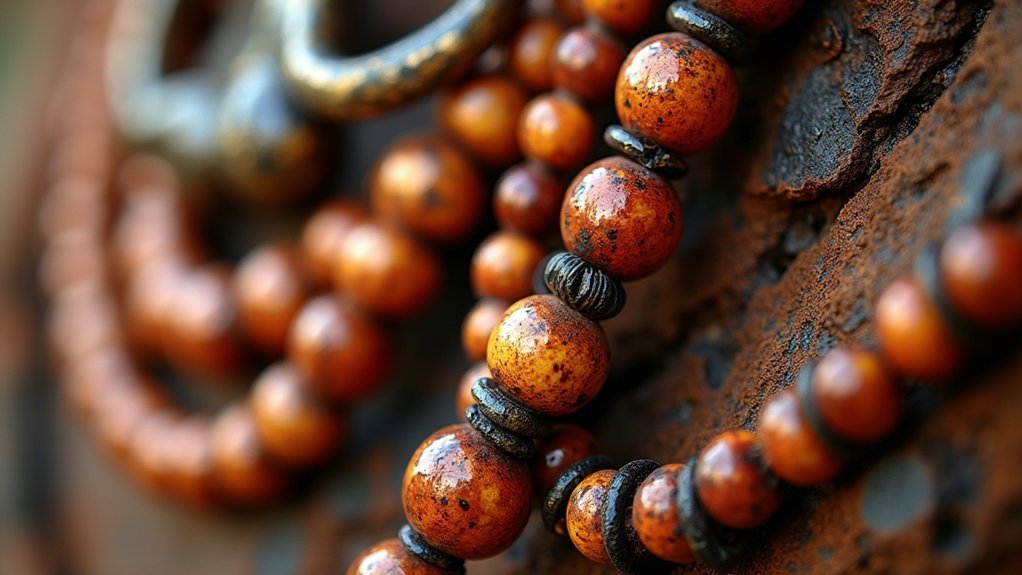



Leave a Reply